
The Movie

TV Series

Tidbits
 The Movie |
 TV Series |
 Tidbits |
The plot |
Technical specifications |
Filming locations |
Behind the scenes
DVDs |
Original motion picture soundtrack |
After the movie |
FAA records
Helicopter production history |
Trivia
Disclaimer: Although I enjoy the design of the helicopter (and the basic premise/plot of the movie itself), it unfortunately contains profanity and, though brief, some sexual content.
| The plot |
Roy Scheider stars in this intense action thriller as a courageous police-officer pilot battling goverment fanatics planning to misuse an experimental attack helicopter. Chosen to test Blue Thunder, Frank Murphy (Roy Scheider) is amazed by the capabilites of the high-speed, high-tech chopper. It can see through walls, record a whisper or level a city block. Distrusting the military mentality behind Blue Thunder, Murphy and his partner Lymangood (Daniel Stern) learn the remarkable craft is slated for use as the ultimate weapon in surveillance and crowd control. Jeopardized after being discovered by sinister Colonel Cochrane (Malcom McDowell), Murphy flies Blue Thunder against military aircraft in a spellbinding contest over Los Angeles.
The whole ship is heavily protected with 1 in. thick armored plates. It is equipped with a forward-mounted 20 mm electric cannon which can fire 4,000 rounds of ammunition per minute.
Contributor Eddie Duca notes that writer's Dan O'Bannon and Don Jakoby's original concept was similar to the movie "Taxi Driver" with Robert DeNiro. According to interviews O'Bannon did for the July/August 1983 issue of Film Comment Magazine and an August 1985 issue of the L.A. Times, the original story had Murphy as a paranoid schizophrenic who would have bizarre hallucinations from his helicopter. Eventually he becomes convinced he's a reincarnation of the Norse god THOR, god of thunder. As O'Bannon put it, he would devastate L.A., turning it into a Beirut like nightmare. O'Bannon mentioned that they even had a scene where the Hollywood freeway collapses (never filmed). The story was changed to make Murphy heroic (and therefore more commercial).
An eight minute behind-the-scenes documentary on the making of the movie was shown on HBO about the time the movie was released.
 |
 |
 |
 |
 |
| Technical specifications |
 |
 |
 |
 |
 |
| Filming locations |
Contributed by David, July 30, 2009:
"The Circus liquor store, where the robbery takes place, is a little harder to figure out where Officer Richard Lymangood was run over, but the area is still the same—the 7-11 is still there, and so is the restaurant where he's running into the parking lot. The only thing that's different is that you can see a gas station across from the parking lot as he gets hit, and as Officer Frank Murphy pulls up—that's now a self-serve Spray Wash. The next one is the parking lot where Murphy pulls in to check his messages. All these locations are in a three-mile radius of each other."
Contributed by Tom Higginson, January 2, 2009:
"I'm an Airwolf fan and have done extensive work on the locations used in that show. I recently discovered the exact location for Pinkville (the Blue Thunder Test Range) during my Airwolf location hunts. I visited the location just a few days ago:"
 Standing on Pinkville |
 Blue Thunder flies over these rocks |
 Prop Jet Ranger from Blue Thunder |
"You can see Pinkville in Google Earth by copying and pasting the following coordinates as-is into Google Earth's "Fly To" search bar:34°54'41.46"N,118°13'11.99"W
I've attached some work I did about the location a few weeks ago, and also a few shots of the spot, taken this week. I had a chance to fly with Doug Holgate, Frank Holgate's son, and can get some great stories for you about his dad's work on Blue Thunder. Frank was a legendary aerial cinematographer, and Doug is easily following in his footsteps. Also, I sat down with Peter McKernan, Sr., who supplied the helicopters for the show (except the Gazelles) and also did the JetRanger crash-landing stunt onto the "break away" construction building. See attachments and last link about that story."
 hawkevision, 4b |
 hawkevision, 5a |
 hawkevision, 6 |
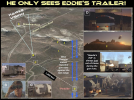 hawkevision, 8 |
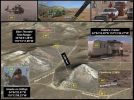 hawkevision, 9 |
 hawkevision, 10 |
 Pinkville, 4 |
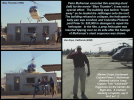 Pinkville, 5 |
Contributed by Curtis Gropp, July 6, 2014:
Curtis shares his set of photos from his trip (July 6, 2014) to Pinkville (approx. 4.5 miles northwest of Rosamond, California), using Tom Higginson's extensive coordinate research. He notes that:
"It's a couple of miles farther off the freeway than I'd thought, but it's not so bad. It's pretty easily accessible, even in my Honda Civic. Looks like a popular shooting area; there are a lot of shot-up appliances lying around. I just keep marveling that I was standing right on top of it and just not seeing it. Even after I went up the hill to look down on it, I couldn't really see the footprint that well. What really threw me off is that in the movie, the ground looks very level, but the actual site has a definite slope."
| Behind the scenes |
Gary Mason shares the link to his publically-accessible Blue Thunder movie filming Flicker photo collection with numerous high-quality behind-the-scenes photos. Contributed on August 20, 2011.
Gary notes that:
"I read with some interest the history of each of the original Gazelles. My father, Thomas J. Mason, was invited to the filming by James Gavin, and he asked me to accompany him. According to my father, he had sold one of the Gazelles used in the filming and that was the reason for the invite. Looking at your histories of the ships, he may have sold one or both of the Gazelles to the original buyers, but apparently not for the movie itself. This is especially true of S/N 1066 as he did a lot of selling to the coal companies of Kentucky and Tennessee. He was LTV's original helicopter test pilot; actually the only helicopter pilot at the time. He then transferred over to Aerospatiale U.S. when LTV gave up its license where he remained as a salesman and pilot until he died about two months after the filming of Blue Thunder."
Photo of the film crew plaque (hanging in the hallway) given to the LAPD Air Support Division in appreciation for their help in the movie. Contributed by Curtis Gropp, July 30, 2011:

Two of the radio-controlled helicopters used in the making of the movie; contributed by Steve Lumsdon, Jan. 1, 2007 (additional photo to right):
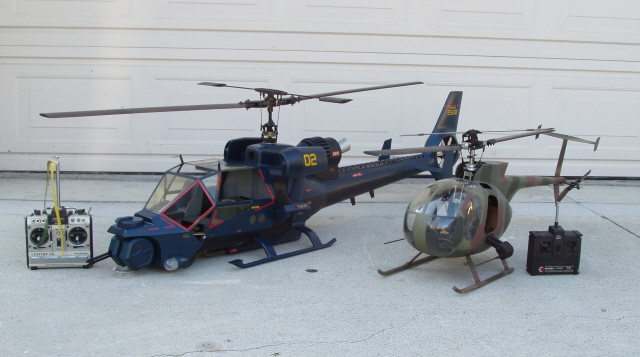  |
Steve shares that:"I just purchased two R/C helicopters used in the making of the movie Blue Thunder. The Blue Thunder model is approximately six feet long and the Hughes 500 is approximately four feet long."
Close-ups of one of the original R/C helicopters used in the movie (source photos). Contributed by Lee Stringer on May 8, 2023.
 |
 |
 |
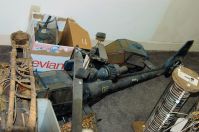 |
 |
 |
 |
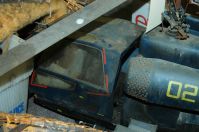 |
 |
Lee notes that: "These were taken on October 28, 2004 in a disused bank in Culver City that Sony was using as a store room for auction items. I was told it was going to be sold on eBay, but never heard about it since. I'm assuming someone purchased it directly. I tried too."
The rendering of Blue Thunder sent to Bayard by Cinema Air. Contributed by Bayard Lawes, Dec. 30, 2006:
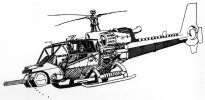 |
A March 8, 1982 article highlighting the downtown battle scene, sent to Bayard by a friend in Los Angeles. Contributed by Bayard Lawes, Dec. 30, 2006:
 |
Two photos of the original Gazelle helicopter used in the movie. Contributed by Bayard Lawes, Dec. 30, 2006:
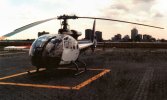 |
 |
Bayard notes that: "I had to lay around San Diego for about a week for funds to transfer to the bank. Rough duty."
An excerpt from Starlog magazine, 1983:
But the true "star" of the movie is Blue Thunder itself. To build it, the production company purchased a French Gazelle (Aerospatiale) helicopter, which can fly at speeds of 200 MPH, and added several prop gimmicks to it.The Gazelle is so maneuverable that the stunt pilots were able to effectively reproduce the 360° loop which Scheider is seen performing on screen.*** Note: This latter (struck-out) statement made by Starlog magazine is false. The weight of the Blue Thunder modifications (the very angular canopy, gun turret, and additional "wings" on the side) made the weight very heavy, especially as the original Aerospatiale SA-341G Gazelle was never designed to fly with additional weight added to it. The first helicopter to ever truly do a complete 360° loop in real life was in fact, a Sikorsky S-52 in 1948. The AH-64A Apache attack helicopter is also able to do a full 360° loop.***
To give Blue Thunder as realistic a look as possible, John Badham mounted cameras on the helicopters, flew them over downtown Los Angeles and shot his daytime close-ups in the sky. It wasn't an easy accomplishment. "Planning to pilot helicopters 50 feet above street level among and between the tall buildings involved a tremendous amount of persuading, cajoling and care," he says.
The production crew had to work on weekends, with the police cordoning off up to 12 blocks at a time. The procedure involved stopping traffic (both motorized and pedestrian) for three-minute periods while shooting took place. Circulation was then allowed to resume for 15 minutes, before another lensing session began.
"It was all very dangerous and very tricky work," Badham remembers. "Our care paid off though, especially the day that one of the helicopters blew an engine while it was 40 stories up and plummeted straight to the ground! The pilot was okay. He had the tremendous skill to be able to put the helicopter down safely. But who knows what would have happened had there been people under there! I was right up there with it in an adjacent helicopter, and it was terrifying."
All was not gloom and doom on the set of Blue Thunder. Badham fondly remembers Malcolm McDowell's fear of flying. "He was terrified. He used to get out and throw up after a flight. But he was also professional enough to get right back in! I had to re-shoot a few scenes, because there were some times when Malcolm's eyes would get wide as saucers. He had held his composure all through the shot, his face would be all stern, but there would be those great big eyes. It was very funny. His wife, Mary Steenburgen, told us, 'I don't know how you got him up there, I can't even get him in a 747!'"
(Note: Two helicopters were used in filming; one as a backup. Hughes Helicopters was the company hired to convert the Gazelle into Blue Thunder. Their main goal of course, was to make the helicopter appear as menacing as possible).
| DVDs |
| Original motion picture soundtrack |
| After the movie |
Contributed by C.M. Owens, January 3, 2002:
"I have some information about one of the helicopters used in the movie. After the film was made, the helicopter was sold to an aviation salvage type guy named Mike Groovy in Clovis, New Mexico. He then leased it out to a film company that was filming the made for TV movie Amerika [an ABC mini-series about Soviet occupation of the USA; the helicopters were painted black, and the surveillance microphones were missing.] After he got it back it was dismantled and sold for parts. My uncle used to have the canopy and the mock up gatling gun that was mounted on the front of it. Unfortunately the canopy was sold about two years ago, and the gun was destroyed when it fell off the trailer my uncle was hauling it on."
(Note: Apparently spare parts from the helicopters were highly valued).
Contributed by Martin Lakin, June 17, 2002:
"Just thought you might like to see these shots I took of apparently all that remains of the two Blue Thunder helicopters—they're residing in pretty poor shape on the backlot tour of MGM studios in Florida. They really are in poor state, but the magic is still there. The annoying thing is you make the tour on a train and don't stop—so you have to take pictures on the move."
Contributed by Lee Malone (owner of the Motion Picture Prop Company, LLC), March 14, 2009:
"I just spoke to the head of the prop area here at Disney Orlando, very nice and extremely helpful. The Blue Thunder was on loan from Columbia/Sony pictures, Disney called to let them know the piece was completely eroded and looking pretty bad. Since the piece was on loan they asked if they wanted it returned and it was decided by the lending studio to scrap it. I tried to save it folks, but I was too late unfortunately. She's gone."
 |
 |
 |
 |
 |
 |
Note: These Blue Thunder remains were actually the mock-up used to film closeups of actors pretending to fly the helicopter. The third photo from the left contributed by Michael Meyers, June 23, 2007. Fourth through the sixth from left are from the Blue Thunder Wikipedia page.
Contributed by Norm Hughes, May 22, 2011:
"This photo is dated July 1987. I saw it at an air show—you can see the "for sale" sign in the front window. I believe it was $105,000. The sign says "flyable" but I remember it didn't have an engine." Later, he adds that "The show must have been in Michigan, since I lived there at the time. I have another shot of the interior. I'll send it when I find it. The interior shot was your typical movie prop with fake looking switches. I thought at the time that it was a shame that the craft was dismantled."
| Helicopter production history |
Contributed by Stipe Zivaljic:
SA.341G, S/N 1066, Production Year 1973
Temporarily registered F-WKQD to SNIAS
1974, July 31 - Registered N57936 to Vought Helicopter Co.
1974, October 2 - Registered N37LR to L.T. Ruth Coal Co.
1974, October 10 - Sold to Kentucky Gem Coal Co. Inc.
1976, November 19 - Purchased to Continental Flying Service, Inc.
1976, December 17 - Registered same registration to Continental Flying Service, Inc.
1976, December 20 - Purchased to L.T. Ruth Coal Co.
1976, October ? - Registered N37LR reserved
1977, January 11 - Registered N37LR to L.T. Ruth Coal Co.
1981, August 19 - Purchased to Columbia Pictures Industries, Inc.
1983, November 28 - Allocated experimental and registered N51BT to Columbia Pictures, Inc.
1984, October 25 - Purchased to Mr. Michael E. Grube
1994, June 23 - W/o dismantled for parts
Notes: a) During 1981, modified as per movie requirements on 1,704.7 total hours done by R.W. Martin, Inc. (Cinema Air); b) Used as modification for film "Blue Thunder" and "Amerika" TV mini-series (pilot: Jim Gavin)
SA.341G; S/N 1075; Production Year 1973
1973, August 7 - Registered N94494 to G. D. Turner (Vought Helicopters Co.)
1973, September 25 - Re-registered N94494 to N777GH Holley & Beck
1977, March 2 - Registered to F.R.B.C. Leasing Co.
1977, March 14 - Leased to Mocomb Contracting Corp.
1980, September 29 - Leased to P. Bosco & Sons, Inc. (formerly Mocomb Contracting Corp.)
1981, August 17 - Purchased by F.R.B.C. Leasing Co. to Moceri Management Co.
1981, August 19 - Purchased to Columbia Pictures Industries, Inc.
1981, November 16 - Allocated experimental and registered N52BT to Columbia Pictures, Inc.
1986, March 21 - Registered same registration to Mr. Michael E. Grube
1988, August 16 - Cof Reg. cancelled
Dismantled (scrapped) for parts, w/o
Note: During 1981, modified as per movie requirements by R.W. Martin, Inc. (Cinema Air)
| FAA records |
Note: You can order FAA records of the Blue Thunder helicopters from the FAA's Aircraft Certification page.
| Trivia |
Contributed by MightyMcT (from France), Oct. 9-10, 2007:
In 2002, there were at least two mentions of a Blue Thunder movie remake by director John Milius:
- "Blue Thunder. John Milius's $70m remake of the actioner, set to star Matt Damon, Burt Reynolds, and Ben Affleck, currently in development with Rastar Productions and Sony/Columbia." (reference)
- A brief mention in a 2002 interview with John Milius, where he states that he will start "the cop movie" (reference) in June—this movie being identified as "Blue Thunder" in the article intro: "He soon begins directing Blue Thunder..." and "I have to make another one first—the cop movie, starting in June." (reference)
- "Blue Thunder Cast (Attached) Active Development" (reference)
- "Don Safran has worked as an executive on many Rastar films, including (...) Blue Thunder and Smokey and the Bandit, both starring Burt Reynolds" (reference)
Note: as of this writing (Oct. 9, 2007), the Internet Movie Data Base lists no movie remake of Blue Thunder in progress.
Contributed by Bayard Lawes, Dec. 28, 2006:
"I used to fly the original SA341 Gazelle (N777GH) which I sold to Columbia Pictures for the film. I delivered the ship from Detroit, Michigan to Cinema Air in Carlsbad, California, who fabricated the conversion to Blue Thunder. My father and I made the trip from Rochester, Michigan to Carlsbad, California in October of 1981. Great trip with the exception of the radios failing in Texas. It was a lot easier getting in and out of controlled airspace back then so we just continued without radios the rest of the way."
Contributed by Brian Campbell:
"If you freeze-frame the movie just after the roll, Blue Thunder no longer has the three-bladed Gazelle helicopter rotor system. It has a two-bladed Bell/Huey rotor system with a stabilizing bar."
Contributed by Rick Markel, Jan. 25, 2005:
"John Simone Jr., with the help of his good friend Lowell Draper, built and flew the radio controlled Blue Thunder helicopter used in the movie; two of which were built at 1/6 scale. Another well known modeler, Ernie Huber, built and flew the Hughes 500 models used in the film. Ernie also built the "Towering Inferno" movie R/C helicopters, which was John's first film. John went on to work on the Clint Eastwood film "Firefox." John Simone Jr. founded the "American R/C" helicopter company in 1976, and was the only R/C helicopter manufacturer in the US at the time. John was the first person to perform a perfect "loop" with a fixed pitch helicopter in national competition. He was also the first person to do a true engine-off "auto rotation" with an American R/C "Commander" (a 60 size ship) back in 1979. The Blue Thunder R/C helicopter was also pictured in magazine ads for some of American R/C's other helicopters in production at the time, until the company folded a few years later."
Contributed by Rick Markel, Jan. 25, 2005:
"The infamous "loop" at the end of the movie was done with a aerobatic rotor head on the ship; the flybar paddles can clearly be seen in the movie during that shot. John flew Blue thunder and performed some 40 loops for the camera with a ship that weighed over 14 pounds—the director loved the loops so much he wanted John to do another each time one was completed. Lowell Draper flew the Hughes helicopter that was shot down by Blue Thunder at the end of the movie. There are several other shots of the model with a scale head (and not as aerobatic) flying between, and around some of the scaled-down buildings. In fact, John had to fly the model between the 1/6 scale buildings for several seconds at a position where he could not see the helicopter, and the crew did not understand that he had to see the ship as he flew it."